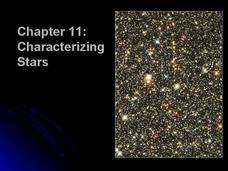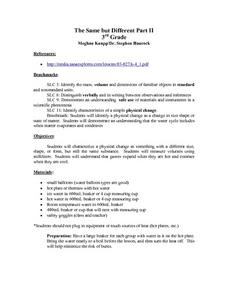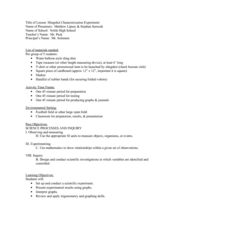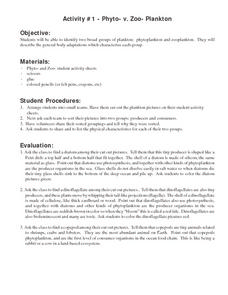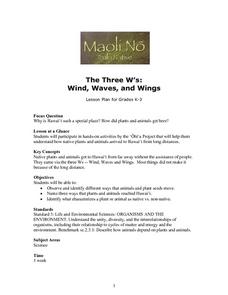Curated OER
Characterization of the Bioluminescence (Lux+) Gene E. coli
Students grow E. coli strain HB101, which contains the plasmid pUCD607 with the bioluminescence (Lux+) gene. The plasmid containing the Lux+ gene is isolated from the E. coli, then characterized by restriction analysis.
Cornell University
Characterizing a Solar Cell
Young classes are sure to get a charge out of this lesson! Learners experiment with circuits of a solar cell. They practice determining current, voltage, and power for the circuit and maximize the voltage and current of the cell.
National Nanotechnology Infrastructure Network
Synthesis and Characterization of CdSe Quantum Dots
Does the size of a sample change the physical properties of that substance? It turns out it can! Young scientists combine physics and chemistry to synthesize CdSe quantum dots and record their color properties. Learners should notice a...
Glynn County School System
Characterizing Stars
Are brighter stars actually brighter? Turns out they are probably just closer! A presentation compares features of stars to our favorite star, the sun. In addition, solar lovers learn to classify stars based on their masses,...
Curated OER
Folktales and Ecology: Animals and Humans in Cooperation and Conflict
Story elements such as conflict, character analysis, resolution, and moral are discussed and charted as elementary children read folktales involving animals. An element of science is also introduced as learners discover what a keystone...
Pace University
Grade 6-8 Living Things
What characterizes a living thing? Scholars explore the concept during a differentiated instruction unit on living things. They perform lab experiments to determine how animals adapt to stimuli, watch videos and learn about...
Curated OER
The Same, But Different Part II
Learners characterize a physical change as something that changes to a different size, but retains its basic substance. They measure volumes using milliliters, and perform an experiment that proves that gases expand when hot and contract...
Curated OER
Slingshot Characterization Experiment
Students set up and conduct a scientific experiment to demonstrate data collection. In this scientific process lesson plan, students complete an activity with the specific objective of using a slingshot to fire a t-shirt into the crowd...
Curated OER
Characterizing Drosophila Mutants
Learners investigate wild-type and several mutant varieties of Drosophila melanogaster, which are characterized and distinguished according to pteridine pigments. They discoverthat paper chromatography of the wild-type Drosophila results...
Curated OER
Space Science: Adventure is Waiting
These full-color handouts feature two activities. The first is a reading on comets, meteors, and meteoroids. Your space science learners will examine ten phrases and determine which of the three each characterizes. The second activity...
Curated OER
Those Particular Plants in Particular Regions
Fourth graders, acting as a botanist, analyze information on different plants in different regions of California. They characterize each plant for each region and answer a variety of question for each plant while doing this study.
Curated OER
Electronegativities of Elements
In this elements worksheet, students use a table showing the electronegativity values of elements to characterize compounds as ionic or covalent. This worksheet has 14 fill in the blank questions.
Curated OER
Asexual Reproduction
Presented clearly and accurately, this PowerPoint introduces biology learners to asexual reproduction in plants. It begins by comparing asexual to sexual reproduction by definition and by the pros and cons of each. The remaining slides...
Curated OER
What Makes a Plant a Plant?
For a plant unit in your biology curriculum, here is a slide show that bestows the basics of plant structure, reproduction, and classification. The information is general. The main point of the lesson is to highlight what characterizes...
Curated OER
EPA's Superfund Program
Young scholars work together to gather information about the EPA's Superfund program. They discuss how to improve human health and the environment. They discover how hazardous wastes are characterized and cleaned up.
Curated OER
Hovercraft
Students assess human impact on water quality. They determine how the force of friction retards motion. Pupils describe and measure quantities that characterize moving objects and their interactions within a system: Time, Distance,...
Curated OER
Forces and Motion
Students are able to analyze gravity as an universal force. They are able to demonstrate ways that simple machines can change force. Students are able to determine how the force of friction retards motion. They are able to describe...
Curated OER
Phyto- v. Zoo- Plankton
Students identify two broad groups of plankton: phytoplankton and zoo plankton. They describe the general body adaptations which characterize each group. They discuss and write about what it would be like to be carried around by the...
Curated OER
Who Has the Data? Monitoring Coral Reefs
High schoolers access data to characterize coral reefs. For this scientific research lesson, students access data and explain the need for such data when monitoring coral reefs. They will identify and explain three major threats to coral...
Curated OER
Solubility Table Exercise
In this solubility worksheet, students characterize compounds as either soluble, slightly soluble, or insoluble. Then students write the chemical formula for each compound. This worksheet has 10 problems to solve.
Curated OER
Hydrocarbons
This worksheet would provide a great assessment for teachers to test student knowledge. High schoolers are asked to complete 3 charts which characterize types of chemical bonds such as alkanes, alkenes, or alkynes. They must also...
Curated OER
Spatial Characterization of Animal Movement
Students identify biotic and abiotic factors which may alter the observed patterns in plant communities with different structural characteristics, climate, or environmental constraints.
Curated OER
The Three W's: Wind, Waves, and Wings
Pupils participate in hands-on acticities to understand how native plants and animals arrived on Hawaii from long distances without the assistance of man. They then identify what characterizes a plant or animal as native vs. non-native.
Curated OER
Literature of the Islands and the Sea
Students read an age-appropriate novel in which an island setting plays an important role from a provided list. This will help them understand life on an island. They will analyze the plot, theme, characterization, setting, and style...
Other popular searches
- Indirect Characterization
- Adjectives Characterization
- Teaching Characterization
- Characterization Worksheets
- Chaucer's Characterization
- Characterization Power Point
- Direct Characterization
- Analyze Characterization
- Characterization Literature
- Characterization Test
- Characterization in Fiction
- Characterization Methods





